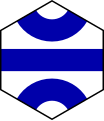Serpentiles
Jump to navigation
Jump to search
Serpentiles is the name coined by Kurt N. Van Ness for the hexagonal tiles used in various edge-matching abstract strategy games, such as Psyche-Paths, Kaliko, and Tantrix.[1] For each tile, one to three colors are used to link the six sides together in various configurations. No sides are linked redundantly (i.e., the paths are unique). Tiles are laid adjacent to existing tiles so that colored paths are contiguous across tile edges.
Van Ness also coined a three-digit notation for tile categories, based on the paths shown on the tiles. The notation xyz refers to:
- x = number of paths linking sides 2 segments apart (opposite sides)
- y = number of paths linking sides 1 segment apart
- z = number of paths linking sides 0 segments apart (adjacent sides)
-
003, indicating the paths link three adjacent sides
-
021, indicating the paths link one adjacent side and two sides one segment apart
-
102, indicating the paths link two adjacent sides and one set of opposite sides
-
120, indicating the paths link two sides one segment apart and one set of opposite sides
-
300, indicating the paths link the complete set of three opposite sides
Variations
[edit]- In Psyche-Paths, three colors are used on cardboard markers
- In Kaliko, three colors are used on Lucite or bamboo markers
- In Tantrix, four colors are used in total (but limited to three per tile) on plastic markers
Complete set of tiles
[edit]The complete set of tiles assuming a combination of three distinct colors per tile is shown in the table below:
References
[edit]- ↑ Van Ness, Kurt N.. Serpentiles. van-ness.com. Retrieved on 8 October 2017.

























































































